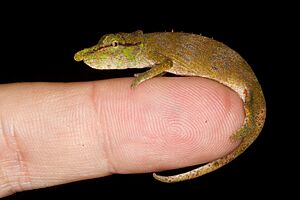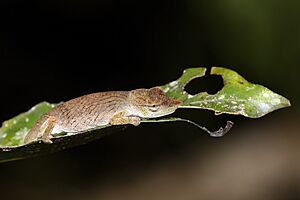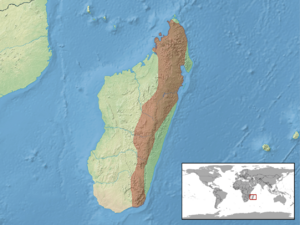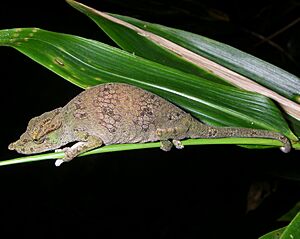Madagascar pimple-nose chameleon facts for kids
Quick facts for kids Madagascar pimple-nose chameleon |
|
|---|---|
 |
|
| Male | |
 |
|
| Female in Andasibe VOIMMA reserve | |
| Conservation status | |
| Scientific classification | |
| Genus: |
Calumma
|
| Species: |
nasutum
|
 |
|
The Calumma nasutum, also known as the Madagascar pimple-nose chameleon, is a small chameleon found in Madagascar. Scientists are still studying this species. They think it might actually be several different types of chameleons that look very similar.
Contents
Meet the Big-Nosed Chameleon!
The big-nosed chameleon is one of the smallest chameleons that lives in trees. It usually grows to about 11 centimeters long. It gets its name from a large, soft bump that sticks out from its nose. This special nose bump helps male chameleons find their mates. Males usually have a bigger, more square-shaped nose bump.
Male big-nosed chameleons also have a more noticeable bony crest on their head. Both male and female chameleons are often brown, reddish-brown, tan, or light green. When female chameleons do not want to mate, they show off bright whitish-blue or turquoise spots. These spots appear on the sides of their nose bump and on top of their head.
Like other chameleons, this species has a tail that can grip things. They also have special toes that are fused together. Their eyes can move in different directions at the same time. And they have an incredibly long tongue to catch their food!
Where Does It Live?
The big-nosed chameleon lives in forests in Madagascar. It can be found in old-growth forests, at the edges of forests, and in newer forests. They like to stay in low plants, like thin trees, shrubs, and bushes. They also enjoy thick vines in the dense rainforest. You will usually find them one to two meters above the ground. They prefer places with lots of leaves and deep rainforests. They are rarely seen in open areas.
How Long Do They Live?
If they are healthy and safe from predators, big-nosed chameleons can live for about 5 to 7 years.
Daily Life and Behavior
The nose-horned chameleon mostly lives alone in trees. It is active at night, looking for food and mates. It uses its long tongue to catch prey, which is a very effective hunting method.
Males and females have different sized nose bumps, which helps them find each other for mating. Females have smaller bumps, while males have larger ones. A cool defense trick of the nose-horned chameleon is its ability to change color. This helps it blend in with the plants around it. This makes it harder for predators to see them.
Chameleons usually move slowly on thin branches and twigs. They use their fused toes to hold on tight. Their tail can act like an extra hand, helping them balance. They use their eyes, which can move separately, to look for small insects to eat.
Sleeping Habits
When it's time to sleep or rest, the big-nosed chameleon often hangs upside down. It clings to a thin twig or vine with its head pointing downwards.
Reproduction and Life Cycle
Big-nosed chameleons reproduce by laying eggs. Female chameleons in zoos have been seen laying several groups of eggs each year. Each group usually has two to six eggs. These eggs are kept warm at about 23 degrees Celsius. They hatch after about 90 days.
What Do They Eat?
The nose-horned chameleon mainly eats small invertebrates. This means tiny creatures without backbones, especially insects. It is a clever hunter that waits quietly for its prey. Then, it ambushes victims like spiders, crickets, and roaches.
Protecting the Big-Nosed Chameleon
The big-nosed chameleon is listed in Appendix II of CITES. This means that any international trade of this chameleon needs to be carefully watched. This helps make sure too many are not taken from the wild.
The government of Madagascar and other groups are working to protect the amazing wildlife on the island. However, there are no specific plans just for the big-nosed chameleon right now.
Threats to Their Home
About 80% of Madagascar's original forests have been destroyed. This is a big problem for the big-nosed chameleon. Their homes are being lost because of "slash-and-burn" farming. This farming method involves cutting down and burning forests. The fires can also damage their habitat.
Even though these chameleons live in many places, they are not found in large numbers everywhere. This means some groups of chameleons might be at risk. Habitat loss from new species, climate change, and deforestation are big challenges for them.
Chameleons and the Pet Trade
Unlike many other chameleon species, the international pet trade is not a major threat to the big-nosed chameleon. However, some reports suggest that more people are starting to want this species as a pet.



